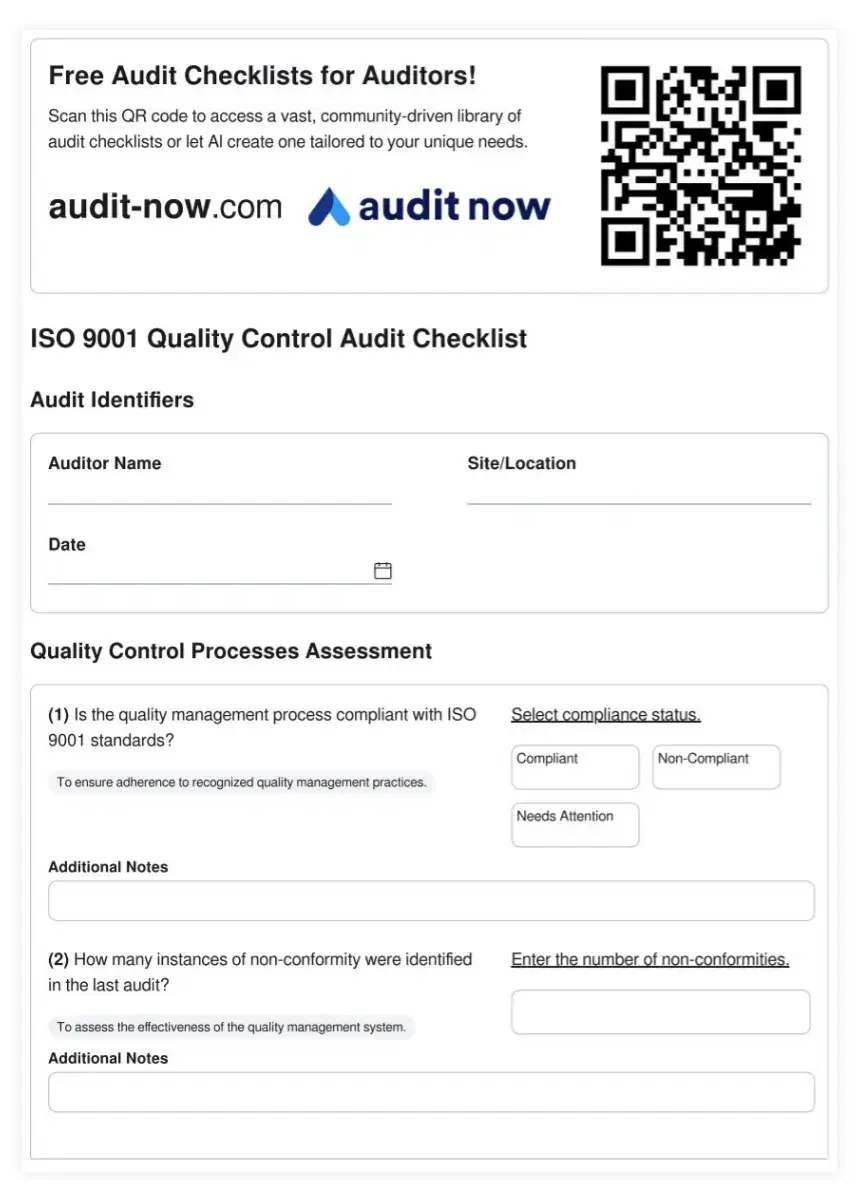Workspace Audits: Ensuring Excellence in Diverse Environments

Featured Checklist

HIPAA Training and Awareness Program Audit Checklist
The HIPAA Training and Awareness Program Audit Checklist is an essential tool for healthcare organizations to ensure their staff education initiatives meet HIPAA compliance requirements. This comprehensive checklist guides covered entities and business associates through the process of evaluating, implementing, and maintaining effective HIPAA training programs. By systematically addressing key areas such as training content, delivery methods, frequency, documentation, and effectiveness measurement, organizations can cultivate a culture of privacy and security awareness among their workforce. Regular use of this checklist not only helps maintain HIPAA compliance but also enhances overall data protection practices, reduces the risk of breaches due to human error, and demonstrates a commitment to safeguarding patient information in an increasingly complex healthcare environment.
Understanding Workspace Audits
Workspace audits are critical evaluations of physical and operational environments to ensure safety, efficiency, and compliance. These assessments cover a wide range of settings, from bustling offices to specialized facilities. Auditors examine various aspects, including:
- Safety protocols: Emergency procedures, equipment maintenance, hazard identification
- Operational efficiency: Workflow optimization, resource utilization, productivity measures
- Compliance: Adherence to industry regulations, legal requirements, company policies
- Environmental factors: Air quality, lighting, ergonomics, noise levels
- Technology infrastructure: IT systems, data security, network reliability
Core Audit Requirements for Workspaces
Effective workspace audits rely on thorough checklists and standardized procedures. Key elements include:
1. Comprehensive Scope
Audits must cover all relevant areas of the workspace, from physical infrastructure to operational processes. This ensures no critical aspects are overlooked.
2. Objective Criteria
Clear, measurable standards help auditors assess performance consistently across different workspaces and time periods.
3. Documentation
Detailed record-keeping is essential for tracking progress, identifying trends, and demonstrating compliance to stakeholders.
4. Regular Schedule
Conducting audits at set intervals helps maintain ongoing compliance and allows for timely corrective actions.
Talk to an Expert
Need help understanding the requirements? Chat with us today for free guidance.
Contact
5. Skilled Auditors
Well-trained professionals with expertise in relevant areas ensure accurate assessments and valuable insights.
Importance of Checklists for Operational Excellence
Checklists play a crucial role in workspace audits, offering numerous benefits:
Consistency
Standardized checklists ensure all necessary items are evaluated consistently across different audits and auditors.
Efficiency
Well-designed checklists streamline the audit process, reducing time and resource requirements.
Accuracy
By providing a structured approach, checklists minimize the risk of overlooking important details or making errors.
Compliance
Comprehensive checklists help ensure all regulatory and industry-specific requirements are addressed.
Continuous Improvement
Regular use of checklists allows for ongoing refinement of audit processes and identification of areas for improvement.
Tailoring Audits to Specific Workspaces
Different workspaces require unique audit approaches to address their specific challenges and requirements:
Office Environments
Focus areas include ergonomics, indoor air quality, fire safety, and data security. Auditors may assess workstation setups, HVAC systems, emergency exit plans, and cybersecurity measures.
Manufacturing Facilities
Key considerations include machine safety, personal protective equipment (PPE) usage, hazardous material handling, and production efficiency. Audits may involve noise level measurements, equipment inspections, and process flow analysis.
Healthcare Settings
Priorities include infection control, patient safety, medical equipment maintenance, and regulatory compliance. Auditors might evaluate sterilization procedures, medication storage, and adherence to HIPAA guidelines.
Educational Institutions
Important aspects include classroom safety, laboratory protocols, accessibility features, and emergency preparedness. Audits may cover chemical storage in science labs, playground equipment safety, and active shooter response plans.
Retail Spaces
Focus areas include customer safety, inventory management, loss prevention, and payment security. Auditors might assess store layout, product display safety, cash handling procedures, and POS system security.
Leveraging Technology for Effective Workspace Audits
Modern audit processes benefit from digital tools and technologies:
Mobile Applications
Allow auditors to access checklists, record observations, and capture photos directly on smartphones or tablets.
Cloud-Based Platforms
Enable real-time data sharing, collaboration among team members, and secure storage of audit results.
Data Analytics
Help identify trends, predict potential issues, and generate insights from audit data across multiple locations or time periods.
Automated Reporting
Streamline the creation of audit reports, saving time and ensuring consistency in documentation.
Integration with Other Systems
Connect audit data with other business systems for a more comprehensive view of operational performance.
Enhancing Workspace Audits with Audit Now
Audit Now offers a comprehensive digital solution for workspace audits, designed to streamline processes and improve outcomes. Our platform features:
AI-Powered Checklists
Customizable, intelligent checklists adapt to your specific workspace requirements, ensuring thorough and efficient audits.
Real-Time Collaboration
Enable team members to work together seamlessly, sharing information and insights throughout the audit process.
Automated Reporting
Generate professional, detailed reports with just a few clicks, saving time and ensuring consistency.
Extensive Template Library
Access a wide range of industry-specific templates to jumpstart your audit process. Explore our collection at https://audit-now.com/templates/.
AI Checklist Generator
Create custom checklists tailored to your unique workspace needs using our advanced AI tool. Try it now at https://audit-now.com/generate-ai-checklist/.
Implementing Audit Now is straightforward:
- Sign up for an account on our website
- Choose from our template library or create custom checklists
- Invite team members and assign roles
- Conduct audits using our mobile app or web interface
- Generate reports and analyze results
With Audit Now, you can elevate your workspace audits, ensuring operational excellence, compliance, and continuous improvement across all your facilities.